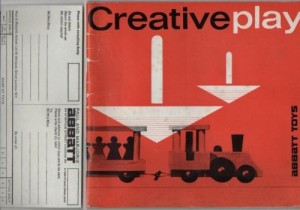An advocate for junk heaps

Cover and invoice of a 1964 informational booklet, “Creative Play” published by Paul & Marjorie Abbatt, Ltd. Image from Pinterest
By the time I interviewed him in 1963, Paul Abbatt and his wife Marjorie had spent thirty years as advocates for the importance of play in the development of young children and for the betterment of children’s toys and playing facilities. Toys commissioned by their toy company, Paul and Marjorie Abbatt Ltd. of 94 Wimpole Street in London, won prestigious international awards for their good quality and design. Paul Abbatt, whose chief interest was in ‘the ethos behind the business,’ delivered lectures and contributed to academic and professional journals on child development.
In 1963, Abbatt was focusing on outdoor playgrounds for older children. He commented that
“…as a society becomes more urban and industrialised, it becomes more and more hostile to the child and its needs. As buildings are packed closer and closer together, available sites become too valuable for industry, or for car parks, to be used for children’s playgrounds. Even the upper class child with a garden of his own is no better off, for custom demands that his parents keep their grounds neat and spotless, and the child has no opportunity for such fundamental activities as building a den, or digging down to Australia.
In keeping with the stereotypes of his time, by older children he meant older boys, assuming that a girl would be “already a mother with dolls, kitchen, a little house of her own.” The interview continues:
Mr Abbatt believes that the solution to the needs of the older child can be found in the adventure playground. The first of these was built several years ago in Copenhagen, where the designer, instead of putting in the usual concrete shapes, swings and slides, filled his playground with builders’ junk. The playground was a great success, and was copied all over Europe. Some cities produced old cars, or traction engines, used tires, and even an old boat.
The first experimental playgrounds, with their carefully manufactured playing facilities, had not been a success. The children were interested at first, but quickly gravitated to the streets just outside the playground, where they were closer to the real life that they knew. But when the material was provided on the sites for them to build their own dens, they could create their own world inside the playground. “Building a den seems to be fundamental to children’s play, and other activities develop round the original den,” said Mr Abbatt. In Zurich, for example, the gang who inhabited one playground built up such a community spirit that they had their own bank with its own play money, a duplicated magazine, an antique shop, and even a farm with a dozen ducks on a man-made pond. When each gang deserts the playground, as they eventually do, the dens are pulled down, and the next gang to come along starts from scratch with the pile of junk.
In the meantime, in Copenhagen, the first adventure playground has become something of a showplace for visiting social workers. The grounds have been tidied up, and the rough dens turned into pretty villas. The visitors look and admire, but the children no longer come.
Similar problems affect playgrounds in Britain. They are normally noisy, untidy, derelict places, a disgrace to the neighbourhood of neat houses with even neater gardens. So local residents complain, and the council tidies up the playground. “In doing so, they destroy the urge for creative activity that the previous junk-heap gave to the children,” said Mr Abbatt.
In preparation for a conference of the International Council for Children’s Play, which Abbatt helped found, he is making a descriptive survey of children in Britain.
He has invited parents to write and tell him what their children do, and, since small boys particularly are notoriously uncommunicative about the activities of their gangs, he is also seeking information from policemen, schoolteachers, traffic wardens, and others who see the children outside their homes. Already the response from parents has been overwhelming.
He hopes that the survey will provide town planners, architects, and designers, with information on what children really want out of their community.
In a note to my editor, I promised a follow-up when the survey results were in. I’ll talk about that in my next blog piece.
Free rein until suppertime was my experience too, Norma. How lucky we were!
I still appreciate my childhood, spent playing amid the barn, outbuildings, and fields surrounding my family’s hotel. Days when no one expected to see our faces except at mealtime. No one checked or asked where we’d been. No one cared if we played in gullies that were forty feet deep, clambering in and out, getting filthy. I don’t remember toys; I remember free-roaming and imagination.